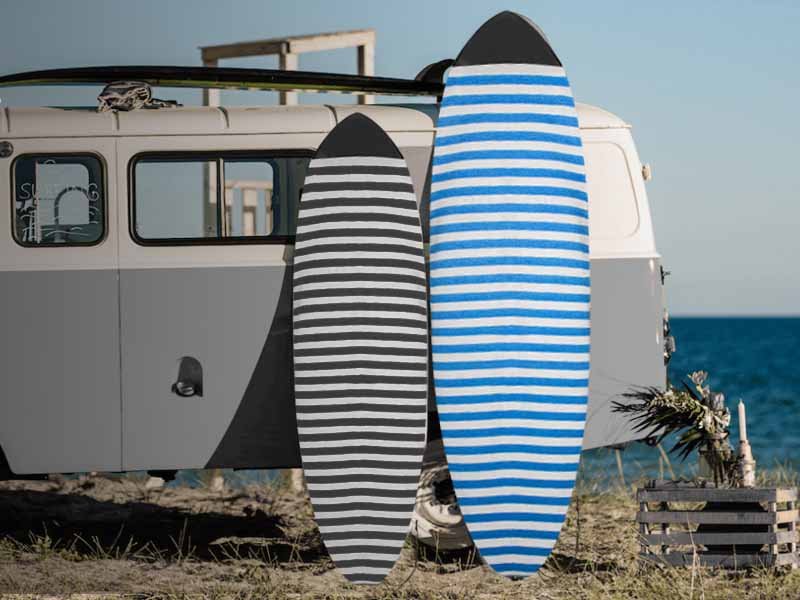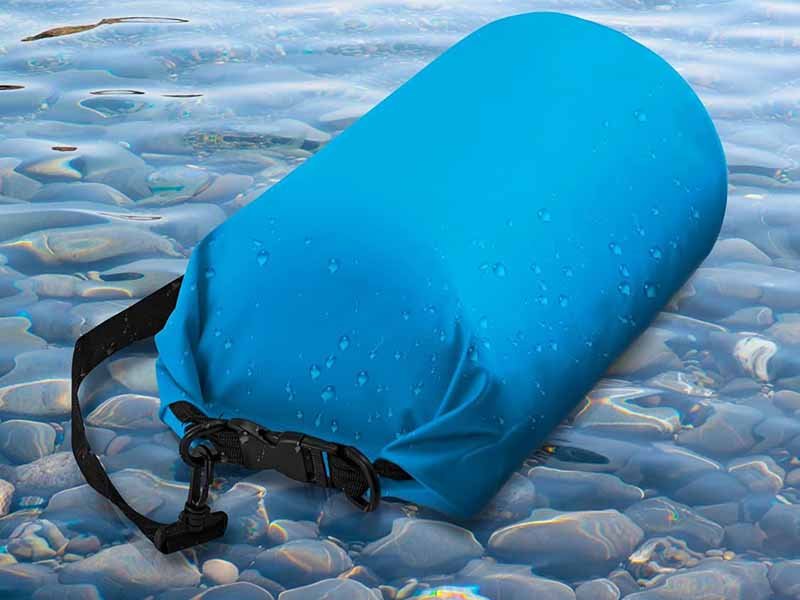Choosing between a golf cart bag and a stand bag can feel like picking your favorite club—each has its unique strengths, and the right one can shave strokes off your score. Whether you’re climbing hills with 14 clubs on your back or riding in comfort while still accessing gear quickly, your bag influences pace, comfort, and even swing confidence.
Golf cart bags excel for riders: they’re heavier (8–12 lbs) with 14-way top dividers, abundant pockets, and secure cart straps. Stand bags weigh 4–6 lbs, feature deployable legs, and comfortable dual straps—ideal for walking 18 holes. Your decision should hinge on whether you primarily ride or walk, how much storage you need, and your tolerance for carrying weight.
What Is a Golf Cart Bag?
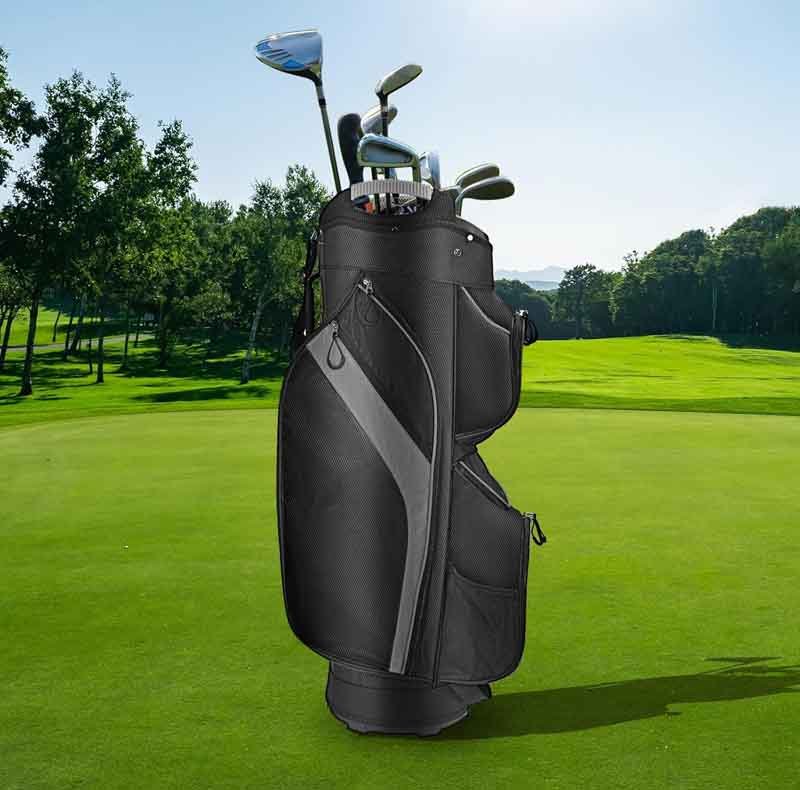
A golf cart bag is engineered specifically for players who predominantly ride in a golf cart rather than walk the course. Its build and features prioritize storage capacity, club organization, and cart stability over lightweight portability. Below, we explore the anatomy of a cart bag, the scenarios it excels in, and the subtle variations that help you decide whether it’s the right choice for your game.
1. Anatomy of a Cart Bag
- Top Dividers: Cart bags typically feature 14-way full-length dividers (or 7-way half-dividers) that completely isolate each club shaft. Full-length dividers prevent tangling and protect shaft finishes during transit on a cart’s rails. In contrast, at the bottom you may see grouped mesh or fabric dividers to save weight without sacrificing accessibility.
- Pocket Configuration: Expect 8–12 pockets: Pocket Type Purpose Full-Length Apparel Holds jackets, rain gear; often insulated. Velour-Lined Valuables Phones, wallets, sunglasses, GPS devices. Cooler/Insulated Keeps drinks and snacks chilled. Ball & Tee Pockets Quick access to golf balls, tees, gloves. Utility Pouches Towels, rangefinders, rain hoods, repair kit.
- Cart-Specific Features:
- Strap Pass-Through System: A dedicated channel at the back allows the cart’s straps to secure the bag without covering pocket zippers.
- Reinforced Base & Gimbal Ring: A sturdy molded base and gimbal ring interface with cart mounts, preventing rotation or twisting on uneven terrain.
2. Optimal Use Cases
- Riding-First Golfers: If 80% or more of your rounds are on motorized carts—due to heat, injury, or simply preference—a cart bag’s heavier weight becomes an advantage rather than a burden. You’ll never notice the extra pounds when the cart bears the load.
- Extensive Storage Needs: Tournament players or weekend warriors often need multiple gloves, extra towels, rangefinders, snacks, and even a small cooler for hydration. Cart bags can handle this “gear overload” gracefully, whereas stand bags quickly run out of room.
- Weather-Variable Conditions: Cart bags frequently include integrated rain hoods and insulated pockets, allowing you to stow wet outerwear and spare gloves without soaking the rest of your equipment. When you’re not carrying the bag, you won’t feel the added bulk of water-logged materials during a brief hike to retrieve an errant shot.
3. Variations Within Cart Bags
- Lightweight Cart Bags: Some manufacturers blend cart-bag features with lighter fabrics (e.g., 400D nylon) and fewer pockets—reducing unloaded weight to around 7–8 lbs. These hybrids suit players who ride but occasionally walk short distances or traverse tight paths.
- Tour-Style Premium Bags: High-end models use ballistic nylon or leather accents, precision stitching, and custom hardware (brass zippers, magnetic snaps). They often carry price tags in the $300–$500 range but offer unparalleled durability and aesthetics.
- Hybrid Carry-and-Cart Bags: For golfers who split rounds between walking and riding, hybrid designs include dual‐strap systems plus cart-strap pass-throughs, along with retractable legs. Unloaded weights hover around 8 lbs, striking a balance—though at a higher price and slightly more complex build.
4. Pros & Cons
| Pros | Cons |
|---|---|
| Maximum storage for gear and refreshments | Heavy (8–12 lbs) makes walking fatiguing |
| Full-length dividers for club protection | Bulkier on narrow cart pathways |
| Specialized cart-strap compatibility | Higher price point ($150–$400+) |
| Insulated and specialized pocket access | Limited dual-strap comfort for occasional carry |
5. Custom OEM/ODM Solutions with Szoneier
At Szoneier, we’ve perfected custom cart-bag production over 18 years. If you need private-label cart bags with:
- Tailored Pocket Layouts (e.g., extra GPS and umbrella sleeves)
- Branded Embossing or Heat Transfer Logos
- Specific Fabric Choices (600D PU-Nylon, waterproof TPU-lamination, premium leather trims)
- Low MOQs and Rapid Sampling
we offer turnkey OEM/ODM services—from material sourcing through quality-controlled production. Whether building a lightweight tour bag or an ultra-durable premium model.
What Is a Golf Stand Bag and Who Is It Best Suited For?
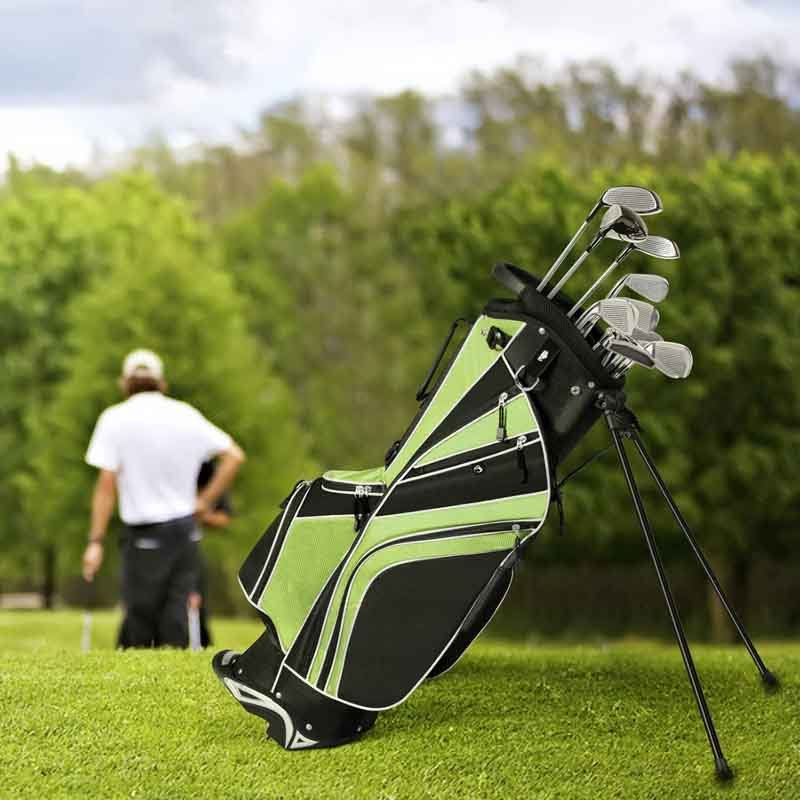
A stand bag is a lightweight golf bag designed for walking golfers, featuring retractable legs, a dual-strap harness, and a streamlined pocket layout (usually 4–6 pockets). Weighing just 4–6 lbs, stand bags prioritize comfort and mobility, allowing players to carry their clubs effortlessly across 18 holes. They’re ideally suited for fitness-focused golfers, those walking short courses, and players who value pace of play and minimal gear. If you trek fairways on foot, a stand bag maximizes convenience without sacrificing essential storage.
Walking the course with a heavy bag can quickly turn an enjoyable round into an exhausting trek. Stand bags address this by blending minimal weight with ergonomic features—here’s how they work, and why they’re the go-to choice for many golfers:
1. Core Design Elements
Retractable Legs and Stability:
Stand bags deploy two or three spring-loaded legs that swing out when you set the bag down. These legs typically lock into place at a 45°–60° angle, creating a stable tripod on uneven terrain. Quality models use rubberized foot caps to prevent slipping on wet grass and to protect the legs from dirt and moisture.
Dual-Strap Harness Systems:
Unlike single-strap carry bags, stand bags employ a backpack-style dual strap with wide, padded shoulder panels and sometimes an adjustable sternum clip. This distributes weight evenly across both shoulders, reducing fatigue and preventing “hot spots.” Some premium harnesses integrate air-flow channels or moisture-wicking fabrics to keep your back cooler.
Lightweight Construction:
Manufacturers shave ounces by using light-denier nylon (300D–600D) or ripstop fabrics, eliminating heavy hardware, and minimizing padding. Frame materials often include aluminum or carbon fiber rods—strong yet light. As a result, stand bags hover in the 4–6 lb range, nearly half the weight of most cart bags.
2. Pocket Configuration & Storage
Stand bags strike a balance between weight savings and essential storage:
- Full-Length Apparel Pocket: Large enough for a windbreaker or rain jacket, though narrower than cart-bag equivalents.
- Valuables Pocket: Fleece-lined and zippered to protect phones, wallets, or rangefinders.
- Ball & Tee Pouches: Located near hip level for one-handed access while wearing the bag.
- Water Bottle/Rangefinder Pocket: Mesh or insulated pockets designed for quick reach.
- Minimalist Extras: Some models include a small apparel pocket or a removable cooler pouch, but designers avoid excess to keep weight down.
3. Ideal User Profiles
Fitness-Oriented Golfers:
Walking the course can burn 1,000+ calories per round. Stand bags appeal to health-minded players who count steps and enjoy the exercise aspect of golf.
Short-Course & Urban Golfers:
On 9-hole or par-3 courses, where pace of play is brisk and distances shorter, a stand bag’s convenience shines.
Weekend Enthusiasts & Beginners:
New golfers often walk during lessons or casual rounds. A lighter bag reduces the learning curve related to carrying and setting up equipment.
Budget-Conscious Players:
Stand bags typically cost $100–$300, making them an economical entry point compared to more expensive cart bags ($150–$400).
4. Trade-Offs and Considerations
While stand bags excel for walkers, they do involve compromises:
- Limited Storage: With fewer pockets, you may need aftermarket attachments (cooler sleeves, rain hoods) if you require extra gear.
- Less Club Protection: 5–7-way top dividers offer decent organization but lack the isolation of 14-way cart-bag dividers.
- Stability vs. Weight: Heavy rain or mud can add weight and reduce leg stability—choosing water-resistant fabrics and easily cleanable materials can mitigate this.
5. Customization and OEM/ODM Options with Szoneier
If a stand bag fits your game, Szoneier offers tailored solutions:
- Fabric Choices: From lightweight ripstop nylon to water-repellent 600D PU-coated textiles.
- Strap and Leg Configurations: Custom harness padding, bespoke leg-lock mechanisms, and branding on straps.
- Pocket Layouts: Design exactly 4–6 pockets to match your accessory needs, including specialized rangefinder or hydration pockets.
- Low MOQs & Fast Sampling: Get prototype stand bags in 2–4 weeks with your logo and specifications for final testing.
Which Key Features Differentiate Cart Bags from Stand Bags?

Cart bags and stand bags cater to distinct playing styles. Cart bags are heavier (8–12 lbs), equipped with 14-way top dividers, 8–12 pockets, and cart-strap pass-throughs, offering maximum storage and club protection for riders. Stand bags, at 4–6 lbs, include dual-strap harnesses, retractable legs, and 4–6 strategically placed pockets, prioritizing portability and comfort for walkers. Your choice hinges on whether you predominantly ride or walk, how much gear you carry, and the terrain you play.
When deciding between a cart bag and a stand bag, it isn’t just about weight—it’s about how every design choice impacts your on-course experience. Let’s unpack the defining features and trade-offs of each.
1. Weight and Portability
Cart Bags:
- Unloaded Weight: Generally 8–12 lbs, rising to 15 lbs when fully loaded.
- Portability Trade-off: Designed to remain on a golf cart, so they lack ergonomic shoulder straps and padded back panels. Carrying them—even for a few yards—can be strenuous.
Stand Bags:
- Unloaded Weight: A nimble 4–6 lbs.
- Ease of Carrying: Dual-strap systems with adjustable, padded harnesses distribute load evenly, making long walks or quick jaunts to the range far less taxing.
2. Club Organization: Divider Systems
Cart Bags:
- 14-Way Full-Length Dividers: Every club has its own slot, preventing tangling and protecting shafts and grips.
- 7-Way Half Dividers: Some lower-tier models offer seven top slots that fan out into larger bottom compartments.
Stand Bags:
- 5–7-Way Dividers: Balance between weight savings and club separation. Often feature a single top ring with segmented inserts below to organize drivers, irons, and putters separately.
- No Bottom Dividers: Lack of full-length separation can allow clubs to shift when walking, but saves ounces.
3. Storage Capacity: Pocket Layout
Cart Bags (8–12 Pockets):
- Full-Length Apparel Pocket: Accommodates multiple layers and rain gear—often fleece-lined or insulated.
- Valuables Pocket: Soft interior for phones, wallets, and electronics.
- Cooler Pocket: Dedicated insulated pocket for beverages, a godsend on hot days.
- Utility and Ball Pockets: Multiple smaller pouches for gloves, tees, repair tools, and rangefinders.
Stand Bags (4–6 Pockets):
- Apparel Pocket: More compact—fits one jacket or sweater.
- Valuables Pocket: Usually fleece-lined but smaller.
- Ball & Tee Pocket: Hip-level for easy access without removing the bag.
- Hydration/Rangefinder Pouch: Often mesh or insulated, designed for quick reach.
4. Carrying Systems and Stability
Cart Bags:
- Cart-Strap Pass-Throughs: Straps feed through a reinforced sleeve so they don’t cover pocket zippers—essential for secure placement and quick access.
- Flat, Reinforced Base: Gimbal ring or molded platform ensures the bag sits securely on cart rails without twisting.
Stand Bags:
- Dual-Strap Harness: Acts like a backpack, often with a stabilizing sternum clip to prevent swaying.
- Retractable Legs: Spring-loaded legs deploy automatically when the bag is tilted, providing a stable stand on various terrains.
- Rubber Foot Caps: Prevent legs from sinking into soft ground or slipping on wet turf.
5. Material Choices and Durability
Cart Bags:
- Heavier Fabrics: 600D–1200D ballistic nylon or PU-coated polypropylene to resist abrasion from cart rails and road debris.
- Weather-Resistant Zippers and Seams: Critical for protecting contents when exposed to rain or dew.
Stand Bags:
- Lightweight Ripstop or 300D–600D Nylon: Strikes balance between durability and weight.
- DWR Coatings: Provide basic water repellency but are less robust than cart bag materials.
6. Cost Considerations
Cart Bags:
- Price Range: $150–$400+. More pockets and heavier duty materials drive higher costs.
- Longevity: Heavier construction typically lasts longer under cart use.
Stand Bags:
- Price Range: $100–$300. Simplified design and lighter materials reduce manufacturing expense.
- Weight vs. Durability Trade-off: Lighter fabrics may show wear faster, but are cheaper to replace or refurbish.
Making the Right Choice
- Riding-Heavy Golfers: If you play primarily by cart, need ample storage for apparel and refreshments, and rarely carry your bag more than a few steps, a cart bag is the logical choice.
- Walking Enthusiasts: Fitness-focused or eco-minded golfers who walk the course value the stand bag’s lightweight profile, ergonomic carry system, and quick-deploy legs.
- Mixed Play: Hybrid models incorporate carry straps, pass-throughs, and moderate leg mechanisms—best for those who ride sometimes and walk other times.
How Do Your Playing Habits Influence Golf Bag Choice?
Your typical round—whether you walk, ride, or alternate—dictates the ideal bag. Walking golfers benefit most from lightweight stand bags (4–6 lbs) with ergonomic straps and deployable legs. Cart riders gain from heavier cart bags (8–12 lbs) that stay put and carry extra gear. Mixed-mode players should consider hybrids with both carry straps and cart-strap pass-throughs. Also factor in course terrain (hilly vs. flat), pace of play, and weather conditions to ensure comfort and functionality every hole.
Your personal approach to the game—how you traverse the course and what gear you bring—directly impacts which bag style will enhance your performance and enjoyment. Below, we explore key habit-driven considerations:
1. Walking vs. Riding Frequency
Walking-First Golfers (70%+ walking):
- Stand Bag Advantages: At just 4–6 lbs, stand bags minimize fatigue over a typical 18-hole walk of 4–5 miles, translating to roughly 10,000–12,000 steps. The dual-strap harness evenly distributes weight, and spring-loaded legs allow you to set the bag down at each shot without stooping.
- Health & Pace: Walking golfers often seek both exercise and a leisurely pace. A lighter stand bag ensures you maintain energy for your swing and enjoy the outdoors without back discomfort.
Riding-First Golfers (70%+ cart use):
- Cart Bag Advantages: When you ride, bag weight becomes irrelevant. Cart bags, though heavier at 8–12 lbs, excel in storage—holding extra apparel, food, and hydration. Features like 14-way dividers protect clubs in bumpy terrain, while strap pass-throughs keep pockets accessible without unstrapping.
- Speed of Play: Cart users prioritize rapid transitions between holes. A well-organized cart bag ensures clubs, balls, and beverages are at arm’s reach, keeping your round flowing smoothly.
Mixed-Mode Golfers (roughly 50/50):
- Hybrid Bags: These bags combine carry straps and retractable legs with cart-strap compatibility. Weighing around 7–8 lbs, hybrids strike a balance—light enough to carry for a hole or two, sturdy enough for cart placement. They require a modest premium but save you from owning two separate bags.
2. Course Terrain & Weather
Hilly or Links-Style Courses:
- Stand Bag Leg Stability: Courses featuring steep elevation changes demand reliable leg deployment. Bags with telescoping or reinforced legs prevent tipping on uneven ground.
- Cart Bag Concern: On hilly terrain, even carts may jostle—choose bags with low centers of gravity and secure gimbal bases.
Wet or Rain-Prone Regions:
- Cart Bags: Often include insulated pockets and rain hoods to shed water, protecting valuables during sudden downpours.
- Stand Bags: Look for DWR-coated fabrics and sealed zippers. A lightweight rain hood attachment can be crucial for walkers.
3. Pace of Play & Round Duration
Competitive Tournaments & League Play:
- Cart Bags for Speed: When each second counts—such as in match play—cart users appreciate that every pocket remains accessible without unstrapping.
- Stand Bags for Focus: Walkers in casual or practice rounds may find that carrying a bag helps maintain a rhythm and mental focus between shots.
Casual & Practice Rounds:
- Flexible Gear Needs: Practice often means extra balls, towels, and training aids. A cart bag’s capacity lets you stock up before heading to the range. Conversely, for quick nine-hole lunches, a stand bag is lighter and easier to manage.
4. Gear Preferences & Storage Needs
Minimalist Carry:
- Walkers who prefer fewer clubs and minimal accessories thrive with slim stand bags offering just the essentials: 5–7-way dividers and 4–6 pockets.
Gear-Heavy Players:
- Tech-savvy golfers hauling rangefinders, GPS units, and multiple clothing layers will maximize a cart bag’s 8–12 pockets, cooler compartments, and divided storage.
Are Cart Bags or Stand Bags More Cost-Effective?
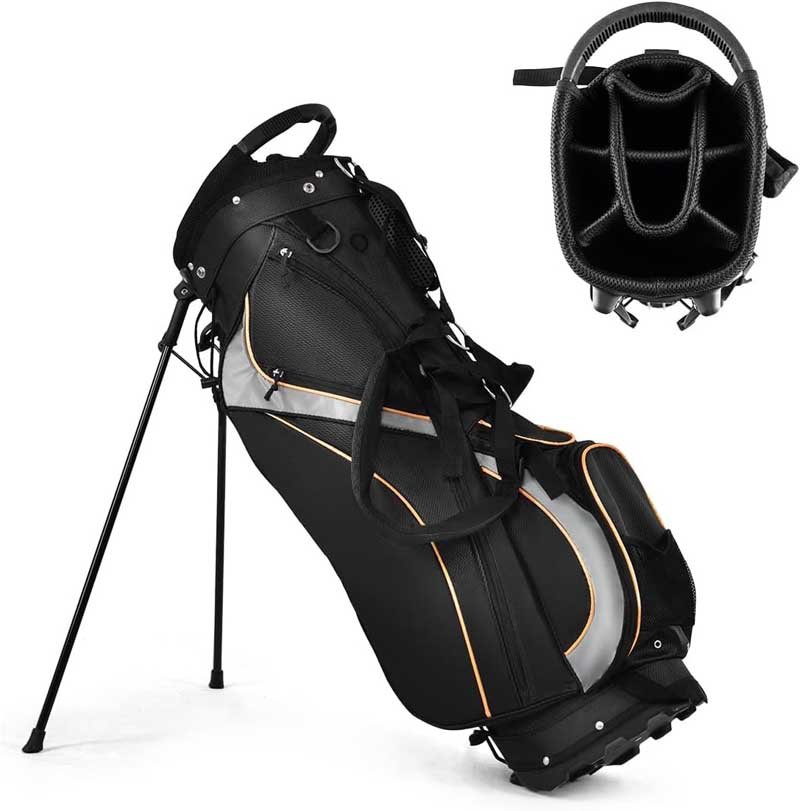
Stand bags typically cost $100–$300, while cart bags fall in the $150–$400+ range. Stand bags’ simpler construction and lighter materials drive lower production costs. Cart bags’ extra pockets, heavier fabrics, and dividers add $50–$100 in materials and labor. Walkers save money upfront with a stand bag and may avoid additional purchases, whereas cart-bag users recoup value by not needing cooler sleeves or extra pouches. Your playing style and gear needs determine which offers the best return on investment.
Cost-effectiveness isn’t solely about the ticket price; it’s about the value per use, durability, and how ancillary expenses factor in over time.
1. Initial Price Breakdown
| Bag Type | Entry-Level Price | Mid-Range Price | Premium Price |
|---|---|---|---|
| Stand Bag | $100–$150 | $150–$250 | $250–$400 |
| Cart Bag | $150–$200 | $200–$300 | $300–$500 |
- Stand Bags start around $100 for basic models with minimal features.
- Cart Bags begin at $150, rising quickly as pocket count and materials increase.
2. Durability and Longevity
- Material Strength:
- Cart bags use 600–1200D ballistic nylon or PU-coated textiles that resist abrasion, extending life expectancy to 5–10 years.
- Stand bags often rely on 300–600D nylon—lightweight but prone to wear, with a 3–5 year lifespan under regular use.
- Cost-Per-Year Analysis:
| Bag Type | Avg. Cost | Expected Lifespan | Annualized Cost |
|---|---|---|---|
| Stand Bag | $200 | 4 years | $50/year |
| Cart Bag | $300 | 8 years | $37.50/year |
While stand bags cost less initially, cart bags’ heavier build often delivers a lower annual cost over a longer lifespan.
3. Ancillary Purchases
- Stand Bag Owners May Need:
- Clip-on Cooler Sleeve: $20–$50
- Rain Hood Attachment: $15–$30
- Rangefinder Pouch: $10–$25
- Total Additional Spend: $45–$105
- Cart Bag Owners Typically Receive:
- Insulated cooler pockets and built-in hoods included—no extra accessories required.
4. Resale and Upgrade Value
- Stand Bags:
- Retain 30–40% of retail value after 2–3 years due to lighter use and fewer premium features.
- Cart Bags:
- Hold 50–60% of retail value after 3–5 years, thanks to robust materials and brand recognition.
Strong resale potential makes higher-end cart bags a more liquid asset if you upgrade frequently.
5. Play Style Impact on ROI
- Walkers (Stand Bag ROI):
- Lower initial investment ($100–$200) aligns with moderate use and fewer storage needs.
- Example: A $150 stand bag used 50 rounds/year yields $3 per round.
- Riders (Cart Bag ROI):
- Higher upfront cost ($200–$300) offset by integrated features.
- Example: A $250 cart bag used 50 rounds/year yields $5 per round but eliminates need for add-on sleeves ($50), effectively lowering net cost to $4 per round.
6. Hidden Savings and Negotiation Tips
- Volume Discounts: Ordering multiple bags or working directly with factories (like Szoneier) can reduce per-unit cost by 10–20%.
- Private-Label Programs: Eliminates retailer markups, delivering cart or stand bags to market at factory-direct rates.
- Lifetime Warranty Offers: Some brands include repairs or replacements, effectively reducing long-term ownership costs.
How Should You Evaluate Comfort and Ergonomics?
Assess strap design (width, padding, adjustability), bag balance on your back, and leg-stand deployment ease. Dual-straps with contoured backs distribute weight; sternum clips improve stability. Lightweight materials and strategic pocket placement prevent “basketball” bounce. Test carrying loaded bags over 50–100 yards to gauge fatigue. For cart bags, ensure strap pass-throughs sit flush on the cart without twisting. Ergonomic comfort drives how long you’ll enjoy your round without aches.
- Strap Systems
- Dual-Strap Harness: Preferred for stand bags—adjustable, padded, and contoured to shoulders.
- Single Strap or Sling: Found on some cart bags for occasional carrying—less comfortable for prolonged use.
- Weight Distribution & Balance
- Center of Gravity: Bags with central weight distribution feel lighter; offset pockets can pull bag off balance when walking.
- Test Walk Protocol: Pack 12–14 clubs plus balls and gear; walk a 100-yard loop to test comfort and bounce.
- Leg-Stand Mechanics
- Deployment: Leg angle and trigger tension should allow smooth opening/closing without stooping or excessive force.
- Material & Foot Caps: Quality rubber grips prevent slipping on wet turf.
- Handle & Grab-Able Features
- Top Carry Handle: Allows quick lifts onto cart or car.
- Side Handles: Useful for loading and unloading.
How to Choose the Right Bag Style for Your Golf Game?

Selecting the right golf bag starts with understanding how you play. If you walk most rounds—whether for health, pace, or course restrictions—a lightweight stand bag (4–6 lbs) with a dual-strap harness and deployable legs is ideal. Look for at least 5–7 way top dividers, hip‐level pockets for balls and tees, and a comfortable carry system. Test‐carry a fully loaded bag over 100 yards to gauge comfort and balance before you buy.
If you ride in a cart the majority of the time, a cart bag (8–12 lbs) delivers superior organization and storage. Prioritize 14‐way full‐length dividers, 8–12 pockets (including insulated cooler and valuables pouches), and a reinforced strap pass‐through system. For mixed play, choose a hybrid bag that combines carry straps, retractable legs, and cart‐compatible features. Align your choice with your typical course terrain, gear needs, and how much you’re willing to carry versus ride.
| Criteria | Stand Bag | Cart Bag | Hybrid |
|---|---|---|---|
| Walking Frequency | High | Low | Medium |
| Storage Needs | Moderate (4–6 pockets) | Extensive (8–12 pockets) | Versatile |
| Weight Tolerance | ≤ 6 lbs | ≤ 12 lbs | ≤ 8 lbs |
| Budget Range | $100–$300 | $150–$400 | $200–$450 |
| Customization Ease | High (simpler design) | Moderate (more pockets) | Complex |
Conclusion
Selecting between a golf cart bag and a stand bag comes down to your playing style, storage needs, and comfort priorities. Whether you walk every hole, ride in style, or split between both, Szoneier’s OEM/ODM expertise means you can customize the perfect bag: from durable 600D fabrics, ergonomic straps, to private-label branding with low MOQs and fast sampling.
Ready to elevate your golf gear? Contact Szoneier today for personalized bag solutions that align with your game, your brand, and your budget.



